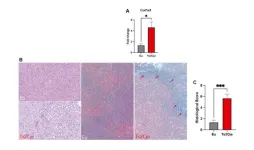(Press-News.org) Cystic fibrosis is one of the most common genetic disorders, causing thick mucus build-up in the lungs and other parts of the body, breathing problems, and infection. A three-drug cocktail known as Trikafta has greatly improved patient quality of life since its development in 2019, but can cause cataracts and liver damage and must be taken daily at a cost of about $300,000 per year.
Now, researchers at the Broad Institute of MIT and Harvard and the University of Iowa have developed a gene-editing approach that efficiently corrects the most common mutation that causes cystic fibrosis, found in 85 percent of patients. With further development, it could pave the way for treatments that are administered only once and have fewer side effects.
The new method, published today in Nature Biomedical Engineering, precisely and durably corrects the mutation in human lung cells, restoring cell function to levels similar to that of Trikafta. The approach is based on a technique called prime editing, which can make insertions, deletions, and substitutions up to hundreds of base pairs long in the genome with few unwanted byproducts. Prime editing was developed in 2019 by the lab of David Liu, who is the Richard Merkin Professor and director of the Merkin Institute of Transformative Technologies in Healthcare at the Broad, as well as a professor at Harvard University and a Howard Hughes Medical Institute investigator.
“We are hopeful that the use of prime editing to correct the predominant cause of cystic fibrosis might lead to a one-time, permanent treatment for this serious disease,” said Liu, the senior author on the study. “Developing a strategy to efficiently correct this challenging mutation also provided a blueprint for optimizing prime editing to precisely correct other mutations that cause devastating disorders.”
Postdoctoral researcher Alex Sousa and graduate student Colin Hemez, both from Liu’s lab, were first authors on the study.
Gene repair
Cystic fibrosis is caused by mutations in the CFTR gene that impair ion channels in the cell membrane that pump chloride out of cells. There are more than 2,000 known variants of the CFTR gene, 700 of which cause disease. The most common is a three base-pair CTT deletion that causes the ion channel protein to misfold and degrade.
Correcting the CTT deletion in CFTR has long been the goal of gene-editing therapies by labs including Liu’s, but most attempts have not been efficient enough to confer a therapeutic benefit, or use approaches such as CRISPR/Cas9 nuclease editing that generate double-stranded breaks in DNA, which can generate unwanted changes in the target gene and other locations in the genome.
Prime editing, a more flexible and controlled kind of gene editing that does not require double-stranded breaks, could help address this limitation. To more efficiently correct the CFTR mutation, Liu’s team combined six different enhancements to the technology. These included improving the prime editing guide RNAs that program prime editor proteins to find their target and to make the desired edit, as well as modifying the prime editor protein itself and other changes that make the target site more accessible. In combination, these refinements corrected about 60 percent of the CTT deletions in human lung cells and about 25 percent in cells taken directly from patient lungs and grown in a dish, an increase from previous methods that corrected less than 1 percent of the mutation in cells. The new approach also generated 3.5 times fewer unwanted insertions and deletions per edit than previous methods that use the Cas9 nuclease enzyme.
Next, researchers will need to develop ways to package and deliver the prime editing machinery to the airways in mice and ultimately humans. The team is hopeful that recent developments such as lipid nanoparticles that reach the lungs in mice may help expedite translation of this approach.
Funding:
This work was supported in part by the National Institutes of Health and the Howard Hughes Medical Institute.
Paper cited:
Sousa AA and Hemez C et al. Systematic optimization of prime editing for the efficient functional correction of CFTR F508del in human airway epithelial cells. Nature Biomedical Engineering. Online July 10, 2024. DOI:10.1038/s41551-024-01233-3.
About Broad Institute of MIT and Harvard
Broad Institute of MIT and Harvard was launched in 2004 to empower this generation of creative scientists to transform medicine. The Broad Institute seeks to describe the molecular components of life and their connections; discover the molecular basis of major human diseases; develop effective new approaches to diagnostics and therapeutics; and disseminate discoveries, tools, methods and data openly to the entire scientific community.
Founded by MIT, Harvard, Harvard-affiliated hospitals, and the visionary Los Angeles philanthropists Eli and Edythe L. Broad, the Broad Institute includes faculty, professional staff and students from throughout the MIT and Harvard biomedical research communities and beyond, with collaborations spanning over a hundred private and public institutions in more than 40 countries worldwide.
END
Prime editing efficiently corrects cystic fibrosis mutation in human lung cells
The approach targets the most common genetic cause of the disease and could enable a one-time treatment as effective as existing daily therapies
2024-07-10
ELSE PRESS RELEASES FROM THIS DATE:
PFA ependymoma brain tumors display unique 3D genome features that could be exploited therapeutically
2024-07-10
Researchers have identified unique 3-dimensional features called TULIPs in the genome of posterior fossa group A (PFA) ependymoma, a difficult-to-treat brain tumor diagnosed in very young children. The findings, published in Cell by a team of researchers at Baylor College of Medicine, Texas Children’s Hospital, McGill University and collaborating institutions, could lead to the development of new treatments.
“PFA ependymomas are lethal. Radiation therapy, the only treatment currently available, is not curative and can cause serious developmental and cognitive issues,” ...
SLAC’s high-speed electron camera uncovers a new ‘light-twisting’ behavior in an ultrathin material
2024-07-10
While taking snapshots with the high-speed “electron camera” at the Department of Energy’s SLAC National Acceleratory Laboratory, researchers discovered new behavior in an ultrathin material that offers a promising approach to manipulating light that will be useful for devices that detect, control or emit light, collectively known as optoelectronic devices, and investigating how light is polarized within a material. Optoelectronic devices are used in many technologies that touch our daily lives, including ...
Jump start your science career: DOE applications for 2025 student internships now open
2024-07-10
WASHINGTON, DC – Applications are currently being accepted for the Spring 2025 term of two programs offered by the Department of Energy (DOE) Office of Science (SC): the Science Undergraduate Laboratory Internships (SULI) program and the Community College Internships (CCI) program. The application deadline for the two programs is 5:00 pm (ET) October 2, 2024.
Through the SULI and CCI programs, undergraduate students and recent graduates discover science and technology careers at the DOE national laboratories and gain the experience ...
New guidance for healthcare professionals to address muscle-building supplement use
2024-07-10
Toronto, ON – In a groundbreaking effort to mitigate the risks associated with muscle-building dietary supplement use among adolescents and young adults, a comprehensive set of guidelines has been introduced to assist healthcare professionals. These guidelines, published in the Journal of Adolescent Health, focus on assessment and harm reduction strategies to better support young individuals engaged in the use of these readily available supplements.
Muscle-building dietary supplements, such as whey protein and creatine monohydrate, are commonly used by adolescents and young adults, particularly boys and young men, and are intended to enhance muscle mass, ...
It is possible to predict cognitive decline in Alzheimer's disease
2024-07-10
Amsterdam UMC's Alzheimer Centre has developed a prediction model that can predict cognitive decline in patients with mild cognitive impairment or mild dementia due to Alzheimer's disease. The next step is developing an app that uses this prediction model, which would represent an important step towards personalised forecasts for patients. The study is published today in the journal Neurology.
After people have been diagnosed with Alzheimer's, their first question is often: "What can I expect now?". This question is difficult ...
Can we predict how fast cognitive decline will occur with early Alzheimer’s?
2024-07-10
MINNEAPOLIS – A new study looks at predicting how quickly people with early Alzheimer’s disease will experience cognitive decline. The study is published in the July 10, 2024, online issue of Neurology®, the medical journal of the American Academy of Neurology. It also looked at how the new drugs recently approved for the disease may reduce decline.
“The rate of cognitive decline varies greatly from person to person, and people are very interested in what to expect from the disease in themselves or their loved ones, so better prediction models are urgently needed,” said study author Pieter J. van der Veere, M.D., of Amsterdam ...
New Consumer Food insights from Purdue explores consumer attitudes toward U.S. farm bill
2024-07-10
The general public has limited knowledge of the U.S. farm bill that politicians are debating on Capitol Hill, according to the June 2024 Consumer Food Insights (CFI) Report.
The survey-based report out of Purdue University’s Center for Food Demand Analysis and Sustainability (CFDAS) assesses food spending, consumer satisfaction and values, support of agricultural and food policies, and trust in information sources. Purdue experts conducted and evaluated the survey, which included 1,200 consumers across the U.S
“Around one-third ...
Lion with nine lives breaks record with longest swim in predator-infested waters
2024-07-10
A record-breaking swim by two lion brothers across a predator-infested African river has been documented in a study co-led by Griffith University and Northern Arizona University.
Dr Alexander Braczkowski, from Griffith’s Centre for Planetary Health and Food Security, led a team that filmed a two-male lion coalition crossing the Kazinga Channel in Uganda at night, using high-definition heat detection cameras on drones. The work was done under the supervision of the Uganda Wildlife Authority.
One half of the lion brother duo was a 10-year-old ...
Pumpkin disease not evolving, could make a difference for management
2024-07-10
URBANA, Ill. -- The pathogen that causes bacterial spot is very good at what it does. Forming small lesions on the rinds of pumpkins, melons, cucumbers, and other cucurbits, it mars the fruits’ appearance and ushers in secondary pathogens that lead to rot and severe yield loss. The bacterium, Xanthomonas cucurbitae, is so successful that it has had no reason to evolve through time or space. That’s according to new University of Illinois Urbana-Champaign research characterizing ...
Aging exacerbates oxidative stress and liver fibrosis in an animal model of Down Syndrome
2024-07-10
“[...] our results put the basis for the use of antioxidants supplementation in Down Syndrome patients to prevent liver-associated pathologies.”
BUFFALO, NY- July 10, 2024 – A new research paper was published in Aging (listed by MEDLINE/PubMed as "Aging (Albany NY)" and "Aging-US" by Web of Science) Volume 16, Issue 12, entitled, “Aging exacerbates oxidative stress and liver fibrosis in an animal model of Down Syndrome.”
Down Syndrome (DS) is a common genetic disorder characterized by an extra copy of chromosome 21, leading to dysregulation of various metabolic pathways. Oxidative stress in DS is associated ...
LAST 30 PRESS RELEASES:
Why nail-biting, procrastination and other self-sabotaging behaviors are rooted in survival instincts
Regional variations in mechanical properties of porcine leptomeninges
Artificial empathy in therapy and healthcare: advancements in interpersonal interaction technologies
Why some brains switch gears more efficiently than others
UVA’s Jundong Li wins ICDM’S 2025 Tao Li Award for data mining, machine learning
UVA’s low-power, high-performance computer power player Mircea Stan earns National Academy of Inventors fellowship
Not playing by the rules: USU researcher explores filamentous algae dynamics in rivers
Do our body clocks influence our risk of dementia?
Anthropologists offer new evidence of bipedalism in long-debated fossil discovery
Safer receipt paper from wood
Dosage-sensitive genes suggest no whole-genome duplications in ancestral angiosperm
First ancient human herpesvirus genomes document their deep history with humans
Why Some Bacteria Survive Antibiotics and How to Stop Them - New study reveals that bacteria can survive antibiotic treatment through two fundamentally different “shutdown modes”
UCLA study links scar healing to dangerous placenta condition
CHANGE-seq-BE finds off-target changes in the genome from base editors
The Journal of Nuclear Medicine Ahead-of-Print Tip Sheet: January 2, 2026
Delayed or absent first dose of measles, mumps, and rubella vaccination
Trends in US preterm birth rates by household income and race and ethnicity
Study identifies potential biomarker linked to progression and brain inflammation in multiple sclerosis
Many mothers in Norway do not show up for postnatal check-ups
Researchers want to find out why quick clay is so unstable
Superradiant spins show teamwork at the quantum scale
Cleveland Clinic Research links tumor bacteria to immunotherapy resistance in head and neck cancer
First Editorial of 2026: Resisting AI slop
Joint ground- and space-based observations reveal Saturn-mass rogue planet
Inheritable genetic variant offers protection against blood cancer risk and progression
Pigs settled Pacific islands alongside early human voyagers
A Coral reef’s daily pulse reshapes microbes in surrounding waters
EAST Tokamak experiments exceed plasma density limit, offering new approach to fusion ignition
Groundbreaking discovery reveals Africa’s oldest cremation pyre and complex ritual practices
[Press-News.org] Prime editing efficiently corrects cystic fibrosis mutation in human lung cellsThe approach targets the most common genetic cause of the disease and could enable a one-time treatment as effective as existing daily therapies



